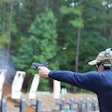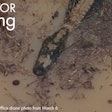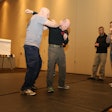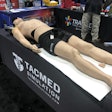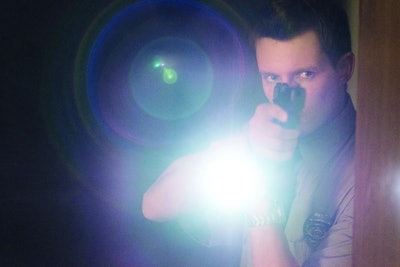 We don't ever want the bad guy to have the advantage in any situation, especially in low light. Turn the lights on and ruin his night vision. (Photo: Getty Images)
We don't ever want the bad guy to have the advantage in any situation, especially in low light. Turn the lights on and ruin his night vision. (Photo: Getty Images)
Police work is often conducted in the dark. And not just on the night shift. Officers have to enter low-light environments for building searches even when it's bright daylight outside. This is the nature of our profession. Criminals like the dark, and we have to know how to counter their use of poorly lit locations and nighttime hiding places.
Types of Light
There are three types of light sources you need to be familiar with to understand low light. Ambient light, reflective light, and direct light.
Ambient light is the light, whether it is manmade or naturally occurring, that is present in the environment in which you are working. An example of manmade ambient light can easily be seen in urban areas. Even when there are no street lights present in an area, there is still enough light present to be able to see certain things and make out certain shapes and objects like a person, a dog, or a vehicle.
From a distance, urban areas seem to glow and stand out from the surrounding darkness in the landscape. That "glow" is the ambient light being cast into the sky from numerous light sources in the city.
Naturally occurring ambient light is the light that is present naturally, like the moon shining at night. However, even when the sky is overcast and there is no moonlight shining through, there is still ambient light present in most areas. If you stand outside in the dark on a moonless night, after a few minutes your eyes will start to adjust to the dark and you'll start to be able to see things and make out shapes and objects like a tree or a big rock.
Because of ambient light you are rarely in total darkness. Even if you were to close the door in a windowless room, ambient light would find its way to creep into the room under the door, or through some other crack or crevice.
Reflective light is light that is bouncing off of other surfaces. Like a street light's glow bouncing off of a light-colored car, making it more visible than the dark colored SUV parked right next to it. How many times have you taken a description of an offender's vehicle where it was described as "a dark colored car?"
Dark colored. What does that mean? Dark green? Dark blue? Dark gray? Because of ambient light the witness could tell the vehicle wasn't white or some other light hue, but there wasn't enough ambient light present or reflective light bouncing back from the surface of the vehicle to be able to tell the difference between a dark green vehicle and a dark blue vehicle.
Direct light, is just that. It's light that is shining directly on an object. An example would be your flashlight shining on a suspect, or your spotlight shining directly on the car you have stopped for a traffic infraction. Let's look at the example of the dark-colored car being observed by the witness leaving the area. As the vehicle left the parking lot it went directly under the street light and our witness could tell it was a dark blue car because there was enough direct light from the street light overhead shining on the vehicle to be able to distinguish the difference between dark blue and some other dark color.
Using Light
With your flashlight you can quickly replicate the three elements of low light. If you go into a darkened room, turn your flashlight on, and shine it on the wall in front of you. By doing this you have created direct light on the wall from the flashlight.
If you look behind you while keeping the beam from your flashlight directed ahead of you, you will see ambient light has partially lit up some of the rest of the room. Although not as bright as the wall in front of you that has the direct beam of light shining on it, the ambient light allows you to see some of the rest of the room.
Now take your flashlight and shine it onto one of the two walls that make up a corner of the room. If the wall is painted a light color, you can make the direct light from your flashlight bounce over and reflect onto the other wall in the corner. Even if the wall is painted a dark color, you can still make your light bounce over onto the other wall, it just won't be as bright. The lighter the color the object is, the more reflective qualities it has.
Flashlight Techniques
Now that we've discussed the three elements of low light, here are a few other tips you can use to your advantage when you find yourself operating in a low-light environment.
The first is to use your flashlight sparingly and intermittently. There is no need to keep the light on constantly as you're clearing a building, or walking up to a vehicle on a traffic stop. By doing this you are not only broadcasting your location to the suspects, you're also not taking advantage of any ambient light or reflective light that may be present. Imagine walking up a set of stairs with your flashlight on the entire time. It wouldn't take a rocket scientist to figure out when you were going to reach the top of the stairs.
Instead, use your light intermittently and flash it in the direction or area you want to move to. Move after the light is off, and continue flashing your light and moving with the light off until you get to the location you want to be in or until the terrain makes it difficult to move with your light off.
If you're traversing rough terrain, and don't want to give your position away by turning your flashlight on, all you have to do is pick your feet up a little higher than you normally do. The U.S. military has been walking in the dark this way for a long time. All you're doing is raising your knees up a little higher than you normally do. It takes a little longer to get to where you're going to, but you'll get there without turning your flashlight on.
Another tactic is to walk by placing your feet flat on the ground. Normally we walk heel-to-toe. Our heel hits the ground first, followed by our toes. Instead, pick your feet up and place them flat on the ground as you walk. It's a little slower than the method of raising your knees a little higher as you walk but it's very stealthy.
Try it yourself on a gravel driveway, and you'll immediately hear the difference between walking heel to toe and placing your feet flat. Combine it with picking your knees and feet up higher than normal, and you can cover almost any terrain quietly. It looks a little odd, and you can't walk a mile using this tactic, but it will easily muffle your movements and allow you to move in the dark.
Lights On
If you find yourself tasked with searching a building or residence in the dark, the first thing you want to do is turn the room lights on. You could walk through the building using these tactics, but I think we can all agree that it's a lot easier, and safer, to search an area that's well lit, rather than trying to work our way through it in the dark.
If someone is hiding in a building, they usually have the advantage of being in the area longer than you. It takes the average person 40 minutes for their eyes to adjust to the level of light they're in. For us cops, our eyes never fully adjust to the level of light we work in.
We've got computer terminals in our cars, passing headlights, our flashlights, and a number of other light sources that affect our night vision, so the bad guy hiding for 20 or 30 minutes before you arrive to search the building, has the advantage when it comes to being able to see better in that particular low-light environment.
That's why you turn the lights on. We don't ever want the bad guy to have the advantage in any situation, especially in low light. Turn the lights on and ruin his night vision, and at the very least put the both of you on the same level playing field.
Here's the other thing to consider. You're a burglar, and you have this great hiding spot you picked out in the dark, and then someone turns the lights on. Now your spot isn't so good, so you decide to move to a better one. For those of us who hunt, we all know it's a lot easier to pick out movement in the woods in contrast to a deer that's standing still in the brush. The same goes for burglars; they're a lot easier to spot when they're moving. Also, when that burglar moves, he's going to create noise, and that's to our advantage. So if you can, turn the lights on at any building search.
Stupid Flashlight Moves
This should probably go without mentioning, but I've seen it enough times that I feel I need to mention it. Don't turn your flashlight on and look directly into the lens; it will completely ruin your night vision. I've never done it, but I assume guys do it to check the charge on their flashlights. A better way is to cup your hand over the lens and turn the light on in your hand. It will still affect your night vision to a certain degree, but not as dramatically as looking directly into the lens.
There are even officers who turn their flashlights on and shine them in other officers' faces. It's happened to me more than once. I'll be in the dark with a couple of officers formulating a plan when one of them turns their flashlight on and shines it in my face. I know damn well you don't know how to read lips, so why would you shine your light in my face? If you can't hear what I'm saying, ask me to whisper a little louder. Don't shine the light in my face.
Even dumber than that is the officer who lights you up at the worst time. You are walking stealthily up to a location and seeing your silhouette appear on the ground in front of you because the guy in back of you has turned his light on. Not only has the officer given everyone's position away, he's made you a great target by backlighting you. Part of your plan before approaching a location should include telling everyone not to use their flashlights if the situation calls for it and reminding them how to walk in the dark by picking their feet up.
Understanding the three elements of low light and learning how to use them to your advantage will make you and your fellow officers safer in low-light situations. When there is enough ambient or reflective light present from other sources, it may be to your advantage not to use the direct light of your flashlight. Why give your position away if you don't have to? Just remember, in most cases the bad guy got there first, and his eyes have had more time to adjust to the level of light, so be safe and use common sense; it's our best tool.
Whether in daylight, or in low light, if we're justified to use deadly force we need two things: target identification, and target acquisition. We need enough light to be able to identify this person as a threat and enough light to acquire/see the target to shoot at the threat. It doesn't matter if that "enough light" is ambient light, reflective light, or direct light.
Michael T. Rayburn has been involved in law enforcement since 1977 and is the author of five books. He is a former adjunct instructor for the Smith & Wesson Academy, and is the owner of Rayburn Law Enforcement Training. He can be reached at www.combatgunfighting.com.










